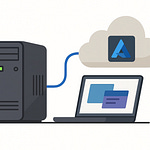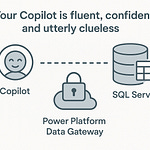Summary
You know that sinking feeling when your Power Pages form refuses to validate and the error messages feel basically useless? That’s exactly the pain we’re tackling in this episode. I walk you through how to use VS Code + GitHub Copilot (with the @powerpages context) to push past Power Pages limits, simplify validation, and make your developer life smoother.
We’ll cover five core moves: streamlining Liquid templates, improving JavaScript/form validation, getting plain-English explanations for tricky code, integrating HTML/Bootstrap for responsive layouts, and simplifying web API calls. I’ll also share the exact prompts and setup you need so that Copilot becomes context aware of your Power Pages environment.
If you’ve ever felt stuck debugging form behavior, messing up Liquid includes, or coping with cryptic errors, this episode is for you. By the end, you’ll have concrete strategies (and sample prompts) to make Copilot your partner — reducing trial-and-error and making your Power Pages code cleaner, faster, and more maintainable.
What You’ll Learn
How to set up VS Code + Power Platform Tools + Copilot Chat in a context-aware way for Power Pages
How the
@powerpagesprompt tag makes Copilot suggestions smarter and tailoredTechniques for form validation with JavaScript & Copilot (that avoid guesswork)
How to cleanly integrate Liquid templates + HTML + Bootstrap in Power Pages
Strategies to simplify web API calls in the context of Power Pages
Debugging tactics: using Copilot to explain code, refine error messages, and evolve scripts beyond first drafts
Full Transcript
You know that sinking feeling when your Power Pages form won’t validate and the error messages are about as useful as a ‘404 Brain Not Found’? That pain point is exactly what we’ll fix today. We’re covering five moves: streamlining Liquid templates, speeding JavaScript and form validation, getting plain-English code explanations, integrating HTML with Bootstrap for responsive layouts, and simplifying web API calls.
One quick caveat—you’ll need VS Code with the Power Platform Tools extension, GitHub Copilot Chat, and your site content pulled down through the Power Platform CLI with Dataverse authentication. That setup makes Copilot context-aware.
With that in place, Copilot stops lobbing random snippets. It gives contextual, iterative code that cuts down trial-and-error. I’ll show you the exact prompts so you can replicate results yourself.
And since most pain starts with JavaScript, let’s roll into what happens when your form errors feel like a natural 1.
When JavaScript Feels Like a Natural 1
JavaScript can turn what should be a straightforward form check into a disaster fast. One misplaced keystroke, and instead of stopping bad input, the whole flow collapses. That’s usually when you sit there staring at the screen, wondering how “banana” ever got past your carefully written validation logic.
You know the drill: a form that looks harmless, a validator meant to filter nonsense, and a clever user typing the one thing you didn’t account for. Suddenly your console logs explode with complaints, and every VS Code tab feels like another dead end. The small errors hit the hardest—a missing semicolon, or a scope bug that makes sense in your head but plays out like poison damage when the code runs. These tiny slips show up in real deployments all the time, and they explain why broken validation is such a familiar ticket in web development.
Normally, your approach is brute force. You tweak a line, refresh, get kicked back by another error, then repeat the cycle until something finally sticks. An evening evaporates, and the end result is often just a duct-taped script that runs—no elegance, no teaching moment. That’s why debugging validation feels like the classic “natural 1.” You’re rolling, but the outcome is stacked against you.
Here’s where Copilot comes in. Generic Copilot suggestions sometimes help, but a lot of the time they look like random fragments pulled from a half-remembered quest log—useful in spirit, wrong in detail. That’s because plain Copilot doesn’t know the quirks of Power Pages. But add the @powerpages participant, and suddenly it’s not spitting boilerplate; it’s offering context-aware code shaped to fit your environment. Microsoft built it to handle Power Pages specifics, including Liquid templates and Dataverse bindings, which means the suggestions account for the features that usually trip you up.
And it’s not just about generating snippets. The @powerpages integration can also explain Power Pages-specific constructs so you don’t just paste and pray—you actually understand why a script does what it does. That makes debugging less like wandering blindfolded and more like working alongside someone who already cleared the same dungeon.
For example, you can literally type this prompt into Copilot Chat:
“@powerpages write JavaScript code for form field validation to verify the phone field value is in the valid format.”
That’s not just theory—that’s a reproducible, demo-ready input you’ll see later in this walkthrough. The code that comes back isn’t a vague web snippet; it’s directly applicable and designed to compile in your Power Pages context.
That predictability is the real shift. With generic Copilot, it feels like you’ve pulled in a bard who might strum the right chord, but half the time the tune has nothing to do with your current battle. With @powerpages, it’s closer to traveling with a ranger who already knows where the pitfalls are hiding. The quest becomes less about surviving traps and more about designing clear user experiences.
The tool doesn’t replace your judgment—it sharpens it. You still decide what counts as valid input and how errors should guide the user. But instead of burning cycles on syntax bugs and boolean typos, you spend your effort making the workflow intuitive. Correctly handled, those validation steps stop being roadblocks and start being part of a smooth narrative for whoever’s using the form.
It might not feel like a flashy win, but stopping the basic failures is what saves you from a flood of low-level tickets down the line. Once Copilot shoulders the grunt work of generating accurate validation code, your time shifts from survival mode to actually sharpening how the app behaves.
That difference matters. Because when you see how well-targeted commands change the flow of code generation, you start wondering what else those commands can unlock. And that’s when the real advantage of using Copilot with Power Pages becomes clear.
Rolling Advantage with Copilot Commands
Rolling advantage here means knowing the right commands to throw into Copilot instead of hoping the dice land your way. That’s the real strength of using the @powerpages participant—it transforms Copilot Chat from a generic helper into a context-aware partner built for your Power Pages environment.
Here’s how you invoke it. Inside VS Code, open the Copilot Chat pane, and then type your prompt with “@powerpages” at the front. That tag is what signals Copilot to load the Power Pages brain instead of the vanilla mode. You can ask for validators, Liquid snippets, even Dataverse-bound calls, and Copilot will shape its answers to fit the system you’re actually coding against.
Now, before that works, you need the right loadout: Visual Studio Code installed, the Power Platform Tools extension, the GitHub Copilot Chat extension, and the Power Platform CLI authenticated against your Dataverse environment. The authentication step matters the most, because Copilot only understands your environment once you’ve actually pulled the site content into VS Code while logged in. Without that, it’s just guessing. And one governance caveat: some Copilot features for Power Pages are still in preview, and tenant admins control whether they’re enabled through the Copilot Hub and governance settings. Don’t be surprised if features demoed here are switched off in your org—that’s an admin toggle, not a bug.
Here’s the difference once you’re set up. Regular Copilot is like asking a bard for battlefield advice: you’ll get a pleasant tune, maybe some broad commentary, but none of the detail you need when you’re dealing with Liquid templates or Dataverse entity fields. The @powerpages participant is closer to a ranger who’s already mapped the terrain. It’s not just code that compiles; it’s code that references the correct bindings, fits into form validators, and aligns with how Power Pages actually runs. One metaphor, one contrast, one payoff: usable context-aware output instead of fragile generic snippets.
Let’s talk results. If you ask plain Copilot for a validation routine, you’ll probably get a script that works in a barebones HTML form. Drop it into Power Pages, though, and you’ll hit blind spots—no recognition of entity schema, no clue what Liquid tags are doing, and definitely no awareness of Dataverse rules. It runs like duct tape: sticky but unreliable. Throw the same request with @powerpages in the lead, and suddenly you’ve got validators that don’t just run—they bind to the right entity field references you actually need. Same request, context-adjusted output, no midnight patch session required.
And this isn’t just about generating scripts. Commands like “@powerpages explain the following code {% include ‘Page Copy’ %}” give you plain-English walkthroughs of Liquid or Power Pages-specific constructs. You’re not copy-pasting blind; you’re actually building understanding. That’s a different kind of power—because you’re learning the runes while also casting them.
The longer you work with these commands, the more your workflow shifts. Instead of patching errors alone at 2 AM, you’re treating Copilot like a second set of eyes that already knows what broke inside 90% of similar builds. The commands don’t give you cheat codes; they give you insight and working samples that respect the environment’s quirks. They save you from endless rework cycles.
On a regular Copilot roll, you’ll land somewhere in the middle. Decent script, extra rework, some trial-and-error before it fits. On an @powerpages roll, it feels like a natural 20—validation scripts slot neatly into your Power Pages form, Liquid includes actually parse, Dataverse bindings don’t throw errors. It’s not luck; it’s what happens when Copilot knows the terrain you’re coding against.
That advantage only gets you the first draft, though. A working snippet doesn’t mean a finished experience. Users type weird inputs, error messages need detail, and scripts have to evolve past the skeleton draft that Copilot hands you. And that’s where the next challenge begins.
From Script Skeletons to Fully Armored Code
From Script Skeletons to Fully Armored Code starts where most validation does—in bare bones. You get a first draft: a plain script that technically runs but blocks only the most obvious nonsense. Think of it as a level-one fighter holding a cardboard shield. It works for one or two weak hits, but the moment real users start swinging, the thing splinters.
Anyone who has shipped a form knows the script never lasts long in its starter state. You guard against easy mistakes, but then a user pastes an emoji into a phone field or types “tomorrow” for their birthdate. Suddenly your defense collapses, tickets hit your inbox, and you’re left with brittle validation doing little more than shaking its arms.
The root issue isn’t just validation coverage—it’s the feedback. A message like “Invalid input” is the software equivalent of a locked door with no sign. It tells users nothing, so they guess, fail again, and eventually throw the problem at you. That’s when your helpdesk tickets multiply for the same predictable reasons.
Here’s the shift: those cardboard scripts don’t need to stay fragile. With Copilot, you don’t just accept the skeleton; you iterate it into armor. And the workflow is simple enough to remember like a four-step loop: generate the skeleton, ask Copilot to improve error messages, then add edge-case handling, and finally, deploy. Every step upgrades the thin hilt into an actual weapon you’d trust in the field.
Copilot works in-session, which makes this fast. Because you’re inside the same chat where the skeleton came from, you just type, “Update code and write detailed error messages.” Copilot doesn’t start from zero; it literally updates the code you had, right in your editor. No spinning between browser tabs or rebuilding prompts from scratch. It’s iterative, not guess-and-paste.
And you can see the impact immediately. Imagine the before-and-after: your first draft throws “Invalid input.” After one refinement, it reads “Phone number must be digits only and at least 10 characters.” That clarity transforms user experience. Instead of a wall, you build a rope guide—they know what went wrong and how to fix it themselves. No ticket, no grumbling, less wasted time on your side.
Push again for edge cases and Copilot expands the armor. Need to check for special characters sneaking into numeric fields? Prompt Copilot in the same thread. Want more layered responses for different failure types? Same workflow. Each time the script hardens a little more, and it does so with context tied to your Power Pages environment, not just generic web code.
What’s really happening is a change in how you debug. You stop firefighting single lines of broken syntax and start sculpting working drafts. Copilot already hands you a functioning baseline, so your energy goes into polishing. Instead of trial-and-error over syntax quirks, you’re deliberately shaping how the code speaks back to the user. That cuts rework hours and trims down support churn.
When you look at it through that loop—skeleton, refine messages, harden against edge cases, deploy—you realize you’re not only preventing data chaos but actively reducing future support load. Every crafted error message is one less “why doesn’t this work” ticket in your queue. Every edge-case handled is one less fragile field waiting to blow up in production.
By the time Copilot’s refinements are layered in, the skeleton still exists under the armor—but it’s completely transformed. What began as a stopgap becomes something resilient enough for production data, with feedback that educates the user instead of blocking them. Like a paper shield reforged into plate, it changes how the fight feels on both sides of the screen.
And while scripted validation is one piece of the puzzle, there’s a bigger battlefield around it. The code can be armored, but the question becomes: how do you manage the entire structure it lives inside without slowing down? That’s where the next challenge shows up—not in the script itself, but in the way you handle the map of your site.
Editing the Dungeon Map with CLI and VS Code
When you want to move beyond single scripts and start managing your whole site, you need more than brute force edits—you need a proper map. Editing the dungeon map with CLI and VS Code is how you stop wandering blind hallways and instead keep every corridor in plain sight.
The messy way is juggling tabs in the browser design studio, bouncing over to a terminal, then shuffling files back and forth just to make a minor change. It works, but it feels clunky. The integrated way is downloading all your site content locally with the Power Platform CLI, then editing and deploying through the Power Platform Tools extension in VS Code. One workflow, no half-step dance.
Here’s how it plays: before you do anything, you authenticate against your Dataverse environment. Think of it as unlocking the front door so the CLI can actually reach your site. Once authenticated, you run a single command to download website content into your local workspace. That pull brings down the templates, scripts, CSS, and assets—an entire copy of your site’s insides—onto your machine. Copilot also benefits, because with local files in place it can reference environment-specific entities instead of lobbing generic guesses.
From there, you’re always in VS Code. Want to adjust a Liquid template? The file is right there. Fix validation logic? Open the JavaScript file sitting beside it. And because it’s all centralized, you see in real time how pieces connect rather than toggling between tools with no context of the bigger picture.
The Power Platform Tools extension makes the CLI commands digestible. You still have the raw command-line at your disposal, but they live in VS Code’s integrated terminal now, tied to the workspace you’re already coding in. That means no memorizing long strings every time—you run the same short commands consistently. Download, edit, deploy. Smooth cycle. No leftover fragments sneaking out of sync.
Deployment itself simplifies too. After making edits, you use the same CLI-powered workflow to push changes back into your Power Pages environment. That closes the loop without the usual double-handling or version mishaps. You aren’t copying folders manually or hoping your browser session hasn’t timed out; you’re keeping everything in one environment you actually control.
And the productivity gain really shows once you add Copilot into that loop. Instead of juggling disconnected snippets, now your @powerpages prompts happen in the same workspace as your site content. You can tweak a validation script and immediately test how it interacts with Liquid templates two tabs away. It’s one environment, one context, one step from question to answer.
To make it concrete, I’ll show you in a short demo: run one CLI command to pull your site down, open both a page’s Liquid file and its validation script in VS Code, then ask @powerpages to upgrade the error messages. That’s the whole cycle—map in front of you, files in reach, AI assistant on standby.
The real win isn’t that you add more tools; it’s that you consolidate them. You eliminate context switches, stay focused, and work inside one stable frame where the coding, content, and assistance line up together. It saves time, but more importantly it keeps you from burning energy on distractions instead of on the actual build.
With the map finally in your hands, you’re no longer stumbling around wondering where the next choke point is. But even with the dungeon layout clear, some fights remain—because when the boss shows up masked as a heap of debug errors, the real test is whether you can read its attack pattern. And that’s a battle many developers still go into blind.
Debugging Boss Battles with Copilot Insight
Sometimes the real test isn’t writing new code at all—it’s figuring out why something you thought was fine suddenly turns hostile. That’s where “Debugging Boss Battles with Copilot Insight” comes into play.
Power Pages debugging can feel like trading blows with a boss monster hiding its attack pattern. Errors look random. The logs scream without context. You dig through long scripts, unsure if the problem is syntax, a Liquid tag misfire, or Dataverse bindings refusing to cooperate. What should’ve been a quick fix eats an entire session because you’re translating gibberish line by line.
Liquid makes this harder. A tiny tag can change the page—sometimes neatly, sometimes spectacularly wrong. One `{% include %}` drops in content without fuss. Another, in a slightly different context, tanks your whole layout. Dataverse bindings add more friction: they may resolve correctly on one form and fail silently on another. Microsoft’s own guidance acknowledges the quirk—Liquid and Dataverse behave differently depending on placement. Which means “just move it around until it works” becomes your unofficial workflow.
That’s precisely where Copilot’s @powerpages participant shifts your odds. Instead of burning an afternoon running blind experiments, you can put the code under a spotlight. You literally type: `@powerpages explain the following code {% include "Page Copy" %}` into Copilot Chat. No hand-waving, no generic advice—the output is a plain-language walkthrough explaining what that tag does, what it pulls in, and why its position on the page affects behavior. In effect, you stop guessing and finally have a readable script of the boss’s moveset.
To make the most of it, structure your debugging like a quick demo. First, identify the buggy snippet—a form implodes after an include tag. Second, drop the exact code into Copilot with the “explain” command. Third, apply Copilot’s explanation to a small rewrite or layout adjustment. Then test. The steps are compact: explain → apply → test. You see results without getting trapped in endless trial and error.
And Copilot goes further than translation. In the same chat, you can ask for a fix. For example, Copilot can suggest adjusting how the include is nested so it plays well with your layout, or it might tweak JavaScript so an event handler fires without collapsing the console. Because it’s running context-aware in your Power Pages workspace, the advice connects directly to your environment rather than floating in generic web space. That’s the difference between a random potion vendor and someone who actually knows the boss you’re fighting.
The benefit is immediate: instead of spending half a day isolating one broken binding, you cut straight to understanding why it fails. That turns debugging from a grindy randomness into something tactical. You see what broke, apply a focused patch, and confirm if the behavior stabilizes. It feels less like pulling dice from a cursed bag and more like reacting to visible patterns.
Here’s the contrast in practice. Before, an error message like “Something went wrong” left you circling the problem endlessly. With Copilot’s explanation, you learn that the include tag loads a specific page fragment, and in your placement it overwrote a required container. You rewrite the placement as Copilot suggests, retest, and the form holds. In three steps, you move from confusion to resolution.
Of course, there’s a rule worth repeating: Copilot makes strong suggestions, but it’s not a guarantee. Always review and test before deploying to production. Treat the outputs as a strategy guide, not as instant loot you can equip blind. They save time, but your judgment keeps the system stable.
Once you build that feedback loop—explain, adjust, confirm—you chip away at the intimidation factor of debugging. Liquid no longer feels like a chaotic trickster, Dataverse quirks stop being total mysteries, and even JavaScript surprises turn into manageable counterattacks. A boss battle is still a challenge, but you’re fighting with vision instead of taking hits at random angles.
And that change in perspective is the real win. Debugging with Copilot Insight doesn’t erase the encounter. You still code, you still test, you still troubleshoot. But you stop wasting energy squinting at mysterious outputs and start rolling with reliable advantage. Which sets the stage for the final piece: what all these changes add up to once you step back and look at the bigger quest.
Conclusion
Conclusion comes down to this: Copilot isn’t skipping fights—it’s changing how you take them. You move from fragile trial-and-error into AI-assisted code that explains itself, refines on command, and builds flows users can actually navigate without rage-quitting.
Here are your five wins: streamline Liquid templates, speed up JavaScript and form validation, get plain-English explanations for tricky snippets, slot in HTML and Bootstrap for responsive layouts, and simplify web API calls without guesswork. Some features are still in preview—tenant admins toggle them through the Copilot Hub in the Power Platform admin center, so check with yours if pieces seem missing.
Boss down. Loot secured. Equip the Subscribe buff, ring the bell for future demos, and drop a comment with the one validation or Liquid problem you’d like Copilot to tackle next—we’ll sharpen future walkthroughs on your toughest tickets.











